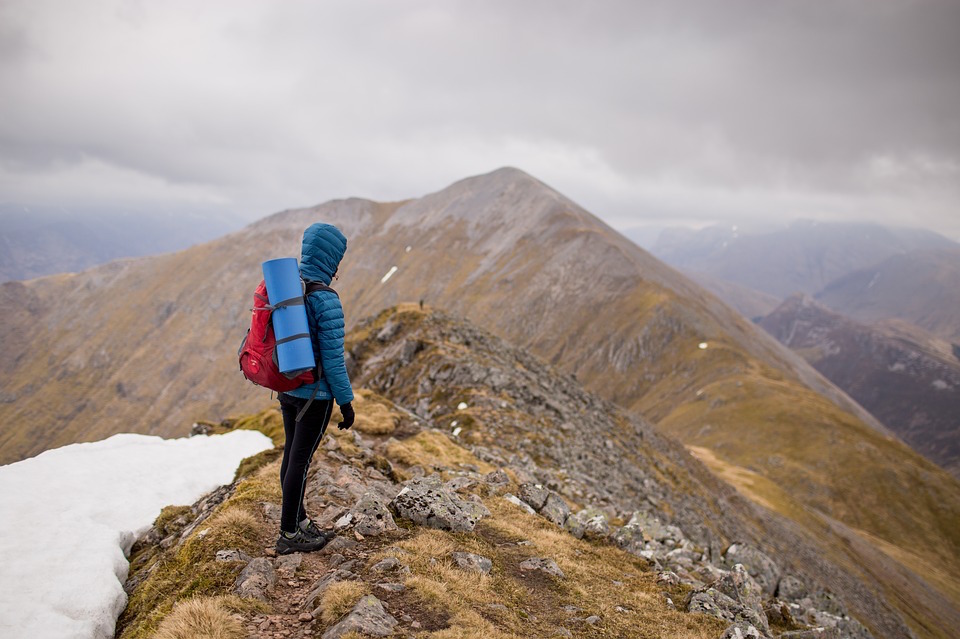If you’re spending long days on the trail you need something that is both comfortable and reliable. So, to help you out, we’ve pulled together six of the best women’s rucksacks for multi-day hiking…
Vango Sherpa 60+10S
www.vango.co.uk | £90
The main compartment of the Vango Sherpa is a good size, I had no issues with fitting all my expedition kit in there. However, I did have a bit of a fight on my hands when it came to packing my sleeping bag in the bottom compartment. After a spot of fisty-cuffs and a slight struggle with zipping it up, I did eventually get the sleeping bag in. When it comes to organisation, the backpack has two large zipped side pockets, two stretch wand pockets, one zipped central pocket, two hip pockets (big enough to fit an iPhone 6), one good-sized zipped pocket in the lid and one small zipped pocket on the lid’s underside.
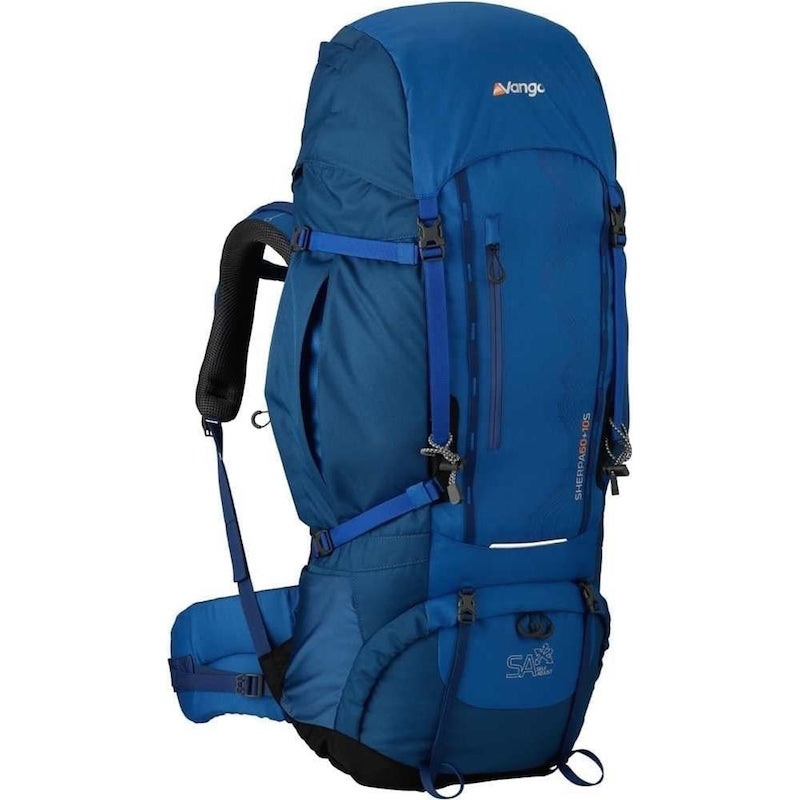
Weighing in at 2.26kg, this backpack was in the middle weight category of all packs in this test. But it benefits from plenty of cushioning on the hip belt, shoulder straps and back padding – so when it’s loaded up and on your back, the straps don’t cause any discomfort. They also feature a mesh material to help wick away the moisture when your back sweats, which keeps you feeling dryer. The back support system is easily changed to fit the length of your back via two adjustment straps, and you can also remove the back system should you wish via Velcro tabs in the main compartment.
Other features on this rucksack include a bungee cord for additional external storage, an emergency whistle on the chest belt buckle, attachment loops, a side haul handle, a drawcord to separate your stuff in the main compartment, and it is hydration bladder compatible. Being cheapest in the test at £90, I think this backpack brings more to the table than some of the other more expensive ones on review and it’s certainly a great option for anyone who doesn’t want to break the bank.
In a line: It may be cheap, but it kept up well with the other rucksacks on test. Best budget buy.
Weight: 8/10
Organisation: 8/10
Comfort: 8/10
Value: 10/10
Features: 8/10
Overall: 8.4/10
Regatta Blackfell 60+10
www.regatta.com | £120
Being a cheaper, entry-level brand, I’m always intrigued to see how Regatta will do in comparison to other more expensive brands, so I was looking forward to testing this one out. It didn’t let me down on space, there was plenty of room in the main compartment for my expedition kit and my sleeping bag slotted in the bottom compartment with ease.
However, I must say it lacks in zip pockets on the outside of the backpack. There is only one small-ish zip pocket on the top of the lid, the rest are mesh stretch pockets – two on the hip belt and two on either side of the pack, along with bungee cord storage to the centre. When I’m on the go, I like to keep my iPhone stashed in one of my hip pockets, so I would be worried to do so with only a mesh pocket for protection in case it got knocked out or it rained. On the inside, there is a large hydration pack pocket.
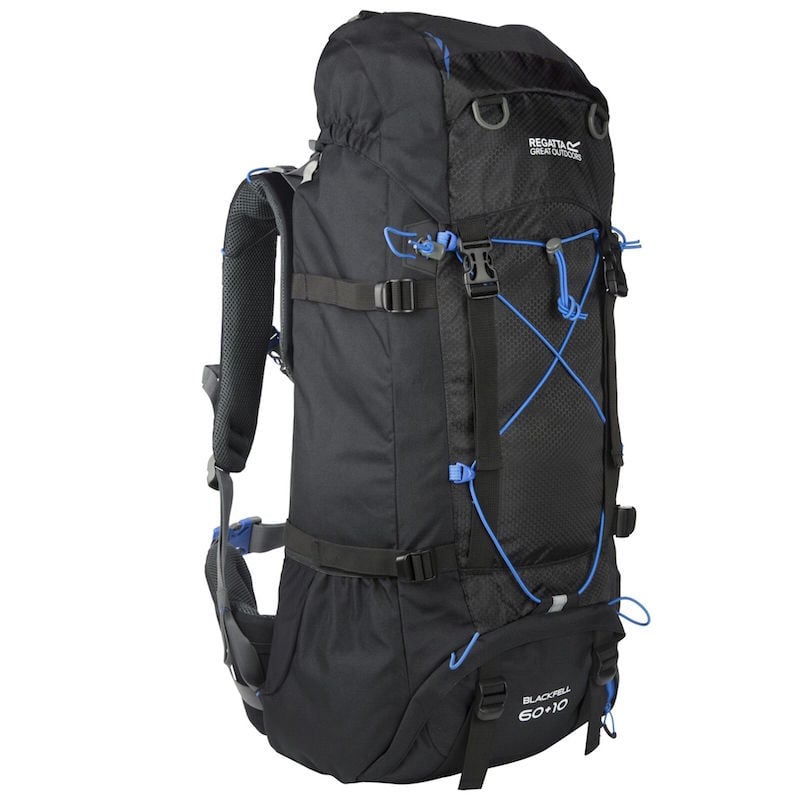
The hip belt, shoulder straps and back padding are all adequately cushioned, I didn’t experience any discomfort when the pack was loaded up on my back, and the weight felt evenly distributed. The back support system is simple and easy to adjust to fit the size of your back. You can also remove the back system via a zip in the main compartment should you wish to make the pack more lightweight.
Weighing in at 2kg, the Regatta backpack was the third lightest in test. The rucksack also has an emergency whistle and rain cover, but there are no attachment loops. It doesn’t have all the bells and whistles that some of the other packs have in this test have, but you can’t really grumble about the lack of fancy extras on an expedition backpack which only costs you £100. I would recommend this pack to anyone who is looking for something cheap and cheerful.
In a line: The Blackfell pack is comfortable and lightweight to wear and it won’t hit your purse too hard. Highly recommended.
Weight: 9/10
Organisation: 7/10
Comfort: 8/10
Value: 9/10
Features: 7/10
Overall: 8/10
Quechua Symbium 70+10
www.decathlon.co.uk | £109.99
First thing I noticed when testing this backpack was the centre zip which runs down the main compartment, this is so handy when you need to grab something from the bag because you don’t have to hurl everything out to find what you need. There is also an abundance of inner and outer pockets which makes easy work of organising all your bits and bobs.
On the outside, there are two zipped hip-belt pockets (plenty big enough to store my iPhone 6), two large zipped pockets on either side of the pack, two stretchy (non-zipped) side wand pockets, a big zipped compartment on the lid, and another big zipped bottom compartment. On the inside, there is a zipped pocket on the inside of the lid.
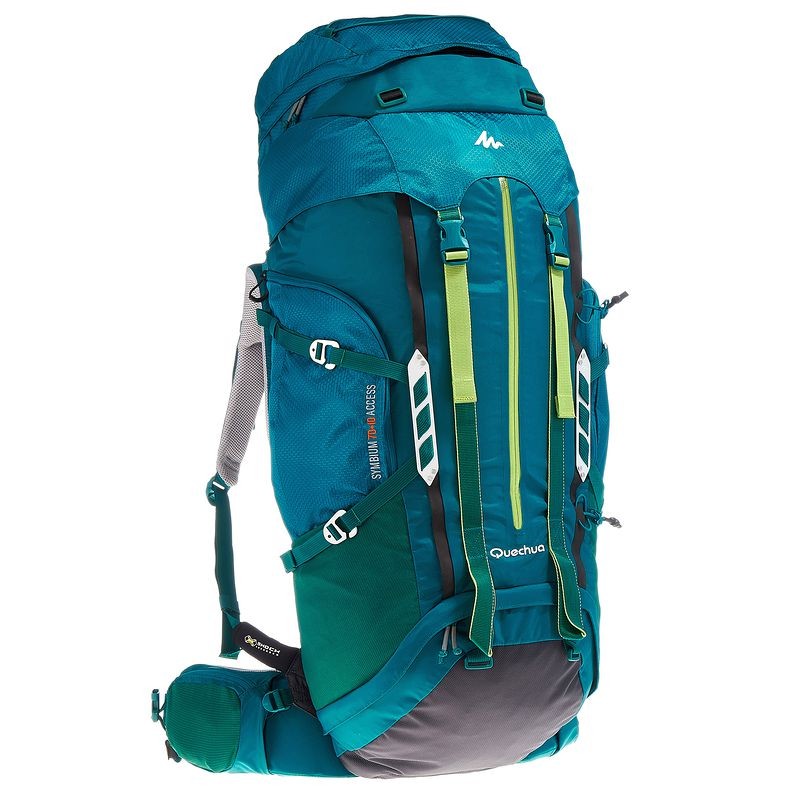
Once the backpack was packed and on my back, I immediately noticed how luxuriously cushioned the shoulder straps, hip belt and back padding were. They also benefit from a mesh material which will help to wick away moisture. I have no complaints about the comfort of this pack. Once I had made all the fine-tuning to the back support via the Velcro adjustment, I found the weight was distributed evenly across my back.
The thing I love most about this pack is that the compartment on the lid of the pack detaches, pulls over your head and gives you access to the pocket, which is perfect for stashing and keeping your valuables safe, along with an integrated map holder. You can also clip it to the hip belt for extra security. The backpack also features a rain cover which is stored via a velcro pocket on the bottom of the pack, an emergency whistle on the chest strap clip, handy adjustable straps which are perfect for stashing walking poles and is hydration pack compatible.
In a line: A spacious backpack that pretty much ticks all the boxes. Best in test.
Weight: 8/10
Organisation: 9/10
Comfort: 9/10
Value: 9/10
Features: 9/10
Overall: 8.8/10
Ferrino Transalp 60W
www.ferrino.it/en | £129.95
Ferrino is a well respected Italian brand that has recently started bringing more of its product range over to the UK, so I was eager to get my hands on the Transalp 60W and see how it performed. I was pleased with the amount of room offered in the main compartment, it was plenty big enough for my expedition kit, and the bottom compartment was a good size for my sleeping bag. You can also access the main compartment from here via a drawstring opening.
When it comes to external pockets there is an abundance. There are two zipped hip belt pockets (which at a squeeze fit my iPhone 6), two large zipped side pockets, two zipped central pockets (one small, one large), and a good-sized zipped pocket with an inner zipped mesh pocket on the lid. Internally, there is one zipped pocket on the underside of the lid.
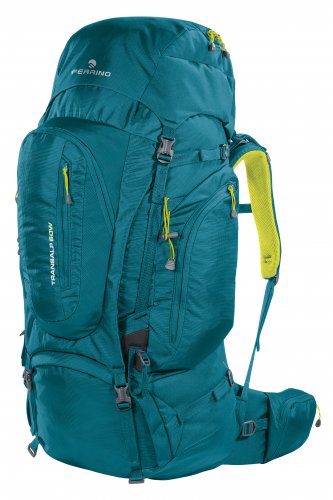
The hip belt and back padding don’t feel particularly well cushioned when you squeeze them but, I have to say, I didn’t feel any discomfort when the backpack was on and the shoulder straps felt well cushioned. They also benefit from mesh material to help keep the sweaty back at bay. You can easily adjust the back support from small to medium via a central strap. The overall fit of the backpack feels well-tuned to the female form and the weight of my kit was evenly distributed across my back.
The backpack also benefits from other features such as a rain cover stashed in the bottom of the bag which is accessible via a Velcro pocket, plenty of attachment loops and is hydration bladder compatible. Out of all the packs I have tested, I thought the Ferrino was one of the most comfortable to wear, however, it was the third heaviest in the test weighing in at 2.5kg.
In a line: Plenty of organisation but a little on the heavier side.
Weight: 8/10
Organisation: 9/10
Comfort: 8/10
Value: 8/10
Features: 8/10
Overall: 8.2/10
Haglofs Rose 65
www.haglofs.com | £180
When I first looked at the Röse backpack I thought to myself ‘how on earth am I going to fit all my stuff in here!?’ – the profile of the bag was very slim and it had no bottom compartment for my sleeping bag. Expecting to have to strap my stuff on, here, there and everywhere, to the outside of the pack, I was pleased to find how roomy it was when I started undoing the compression straps. It was at this moment that I ate my words, so to say, as all my expedition kit went in with ease – sleeping bag and all!
The cushioning on the hip belt, shoulder straps and back padding felt really hard, so I was worried that the bag would feel uncomfortable when on. However, I have to say, once I had adjusted the straps to fit me and changed the velcro back support to fit the length of my back, the bag was very comfortable – the Röse pack had proved me wrong again.

I was disappointed at the lack of external pockets though, especially seeing as there is no bottom compartment, I could definitely do with some extra stashing spaces. There are no hip belt pockets either, however, there are two stretch wand pockets on either side of the bag which are ideal for water bottles and the lid does have a zipped pocket. The centre of the bag also has drawcord storage.
You can access the main compartment of the bag via a large zip at the bottom of the bag, which makes very easy work of reaching your stuff without having to lug everything out to find what you need. The backpack also benefits from attachment loops for walking poles or ice axes and a rain cover. The pack is not hydration pack compatible which I think is a big overlook for an expedition pack. The Rose 65 weighs in at an impressive 1.9kg, which makes it second lightest in test and retails at a respectable £180.
In a line: A lightweight pack that proved my pre-judgements were wrong.
Weight: 10/10
Organisation: 6/10
Comfort: 8/10
Value: 7/10
Features: 7/10
Overall: 7.6/10
www.vaude.com | £190
Packing doesn’t prove an issue with the Astrum backpack as there is plenty of room for all your expedition kit in the main compartment and there is a generously sized bottom compartment which is perfect for stashing your sleeping bag or dirty clothes in.
You can also access the each compartment from the other thanks to a zip divider inside. For external organisation, there are two stretch side wand pockets which will happily take water bottles, one large zipped pocket on the lid, but only one hip belt pocket (but this is big enough to fit an iPhone 6). Inside, there is a zipped pocket on the underside of the lid for any other valuables that you might want to keep close to hand.
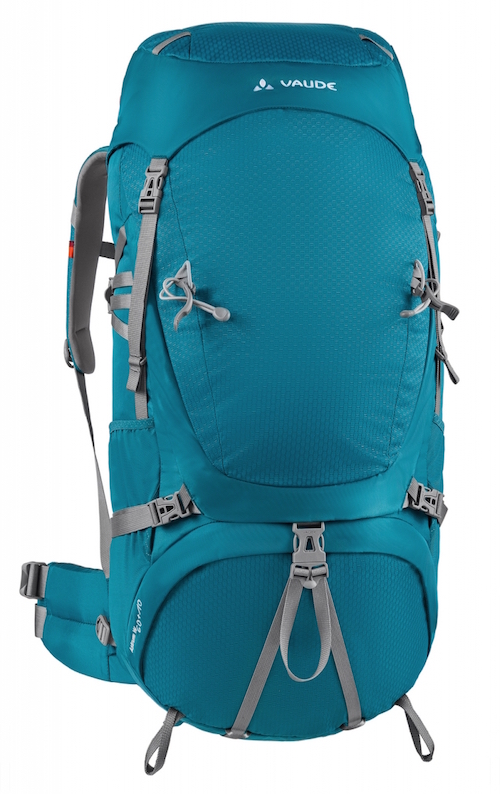
I found the cushioning on the shoulder straps to be quite firm, though I did not find this uncomfortable. I did find that the hip belt was a little too hard against my hips (even though it felt pretty cushioned when I squeezed it with my hand), but this could change over time. The back padding felt well cushioned and wasn’t too hard against my back and it benefits from a honeycomb type of mesh, which not only works to wick away moisture but allows air to circulate behind your back to help keep you cool. You can also easily adjust the back support by using a central clip adjustment system.
Other features include an emergency whistle on the chest belt buckle, an SOS instruction label on the inside of the lid, a top haul handle, attachment loops, and the backpack is hydration pack compatible. The bottom of the Astrum also houses a rain cover which is accessible via a zip and is also detachable by a small clip. Vaude’s backpack came in second heaviest in the test at 2.54kg and retails at £190, making it the second most expensive women’s pack.
In a line: Plenty of room for your kit and will keep things cool behind your back.
Weight: 7/10
Organisation: 8/10
Comfort: 8/10
Value: 8/10
Features: 8/10
Overall: 7.8/10
These reviews first appeared in Adventure Travel magazine issue 132 (Nov/Dec) as part of a wider test. You can view the full test by buying the latest issue here.



